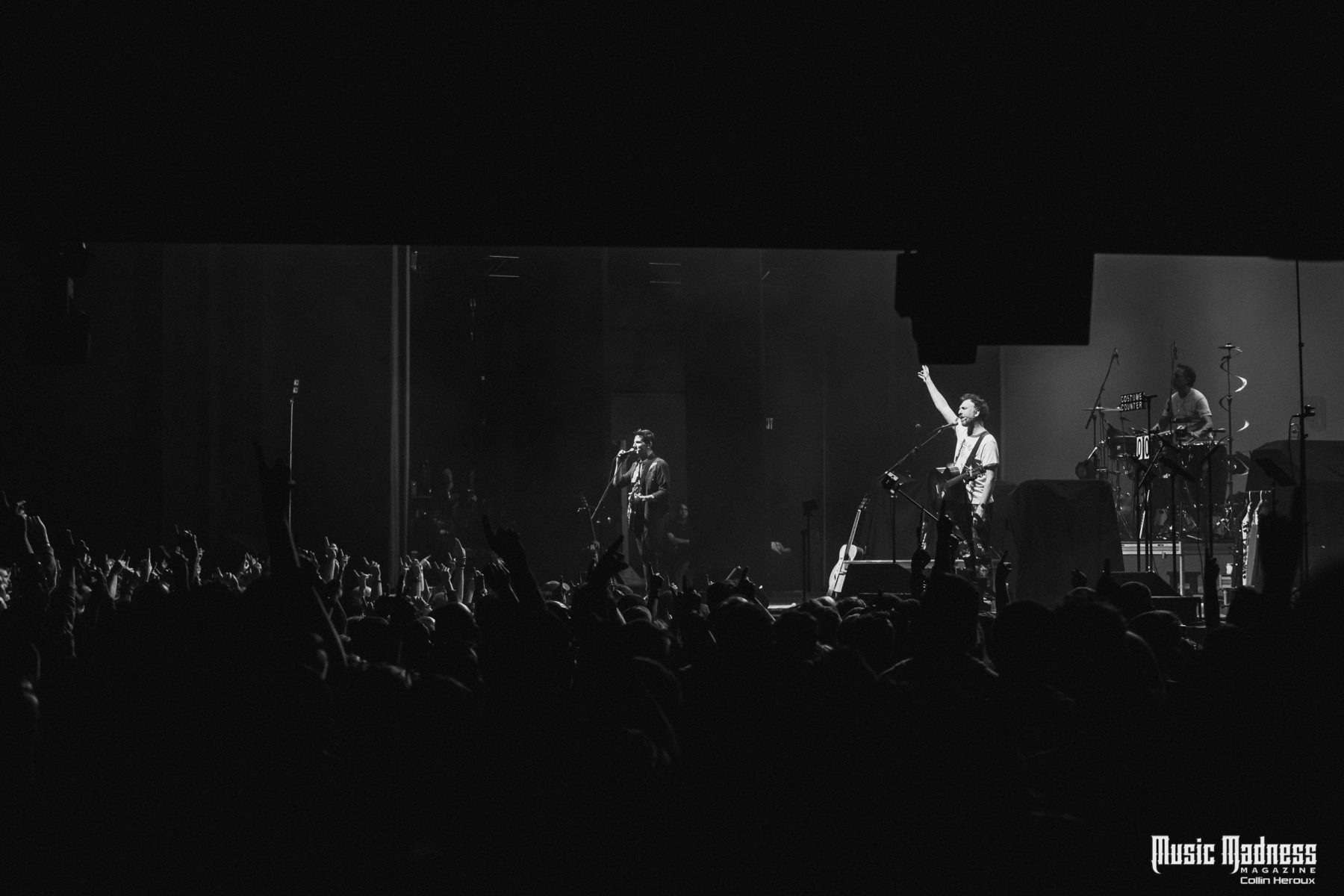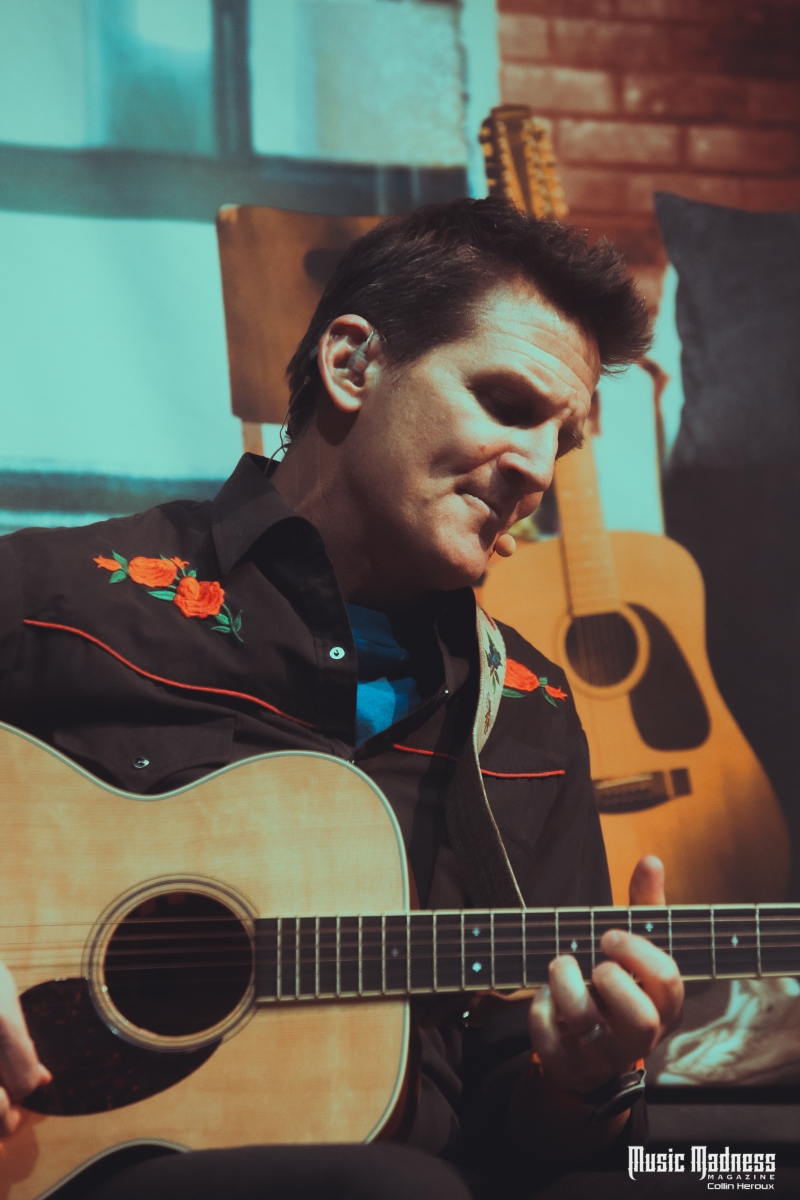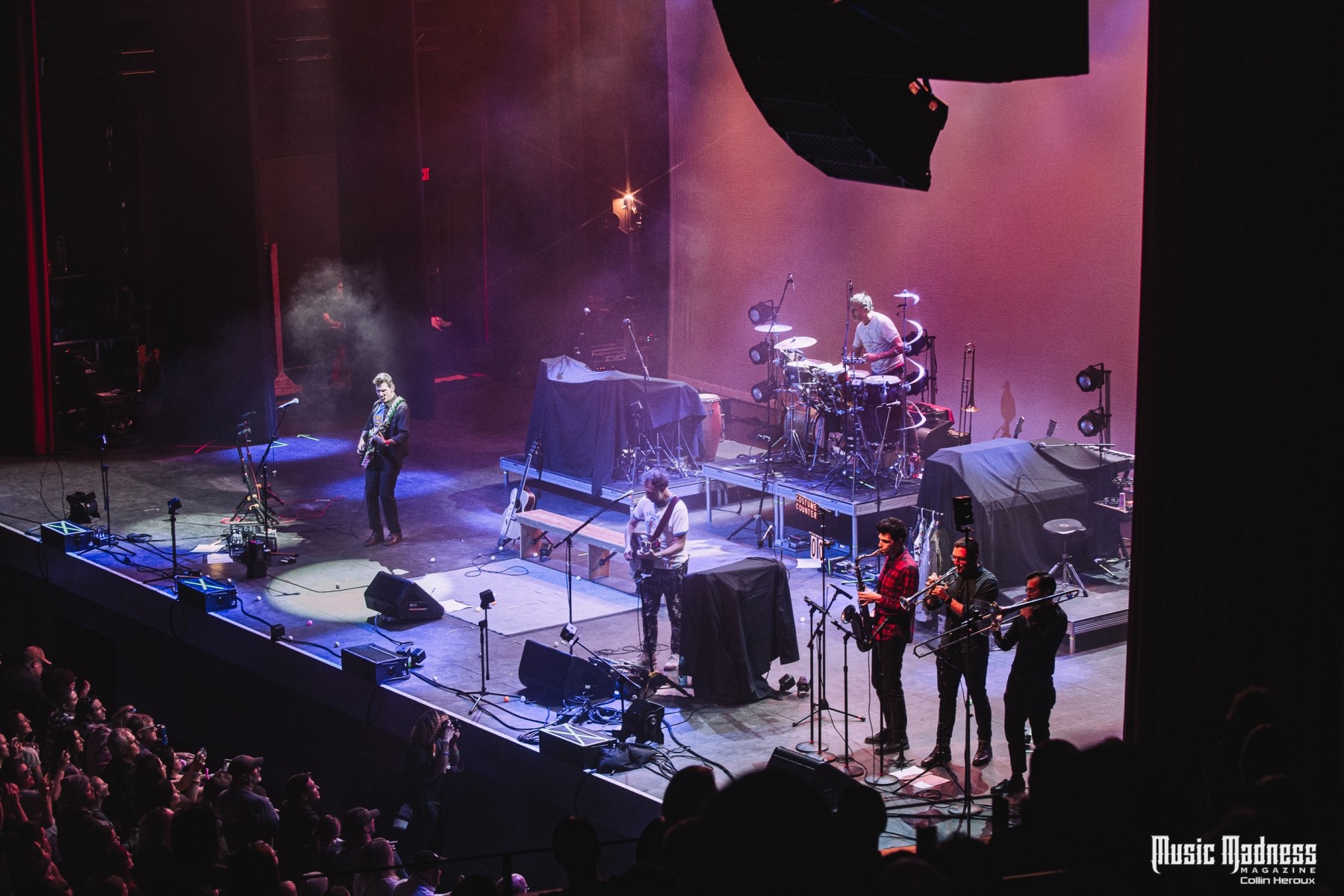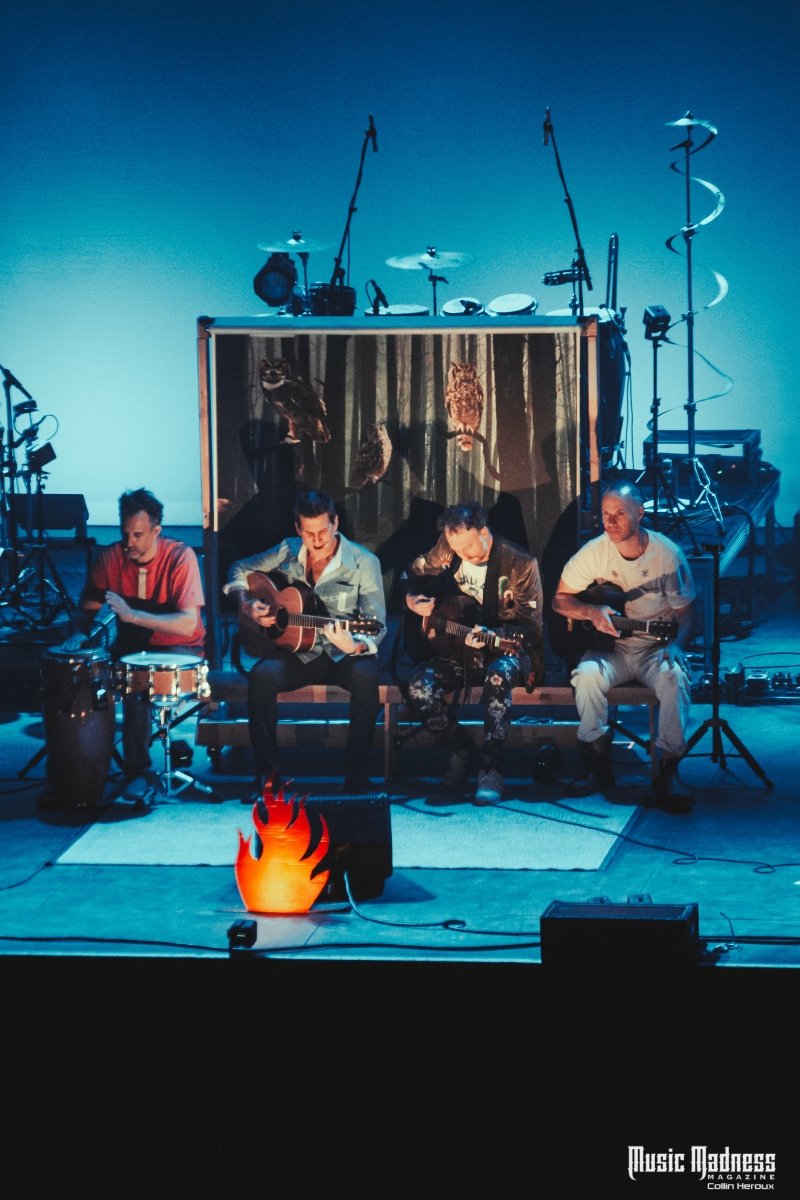
Guster has, to say the very least, a special place in the history of Boston – the indie rock band formed in the early 90s while original members Adam Gardner and Ryan Miller attended Tufts University, soon to be joined by drummer Brian Rosenworcel. Ever since they’ve been a beacon of fantastically unique music that’s tethered to this strange geographic location. For their “We Also Have Eras” Tour – borrowing winkingly a format afforded by Taylor Swift – they’ve sold out the many levels of the new-ish MGM Music Hall at Fenway for a glance through their genesis that goes all-out on production value in chronicling the rise and tribulations of a band that has become a true gem of New England across the past three decades.
You can see it simply walking around the venue before the show, just in the merch people have brought from previous gigs – a key Guster shirt co-opted the iconic Citgo sign that’s visible upon entering Boston; perhaps an unlikely candidate for a cultural touchstone for both the band and the city, but one that has nonetheless spread to their print house of choice. The entryway to the venue also forecasts the future: balloons affixed to the second-floor railing read Ooh La La, the title of Guster’s upcoming ninth record, to be released May 17th.
Guster have existed now for over 30 years, and they’ve experimented with a wealth of musical stylings in that time: from the stomping, electric ‘Barrel of a Gun’ to the proggy organ swells of songs like ‘Ruby Falls’, and of course the acoustic-and-piano triumph of their 2010 album Easy Wonderful. The band’s extended night at MGM Fenway begins with a solo set from longtime friend and member of Bonny Light Horseman Eric D. Johnson. Performing as ‘Fruit Bats’, he uses simply his voice and acoustic guitar to render gorgeousness like his own ‘Baby Bluebird’, as well as a cover of INXS hit ‘Never Tear Us Apart’. He’s one of many folks who speak highly of Guster, and during his set, astute eyes can pick out a bounty of guitars already placed onstage, including one wearing what is essentially a knit sweater.
Guster arrives, initially as a duo, to big cheers – Miller and Gardner occupy the ‘Acting Bench’, which at first is backed by a projection of a college dorm, and they facetiously dramatize the circumstances under which the band was created at Tufts in ‘91. Some Arrested-Development/Ron-Howard-style narration comes in via musician Dave Butler, who plays double duty as the omniscient guide for the evening when he’s not playing with the band. Gardner reveals the process by which their original name of Gus became Guster; and upon introducing drummer Brian “The Thunder God” Rosenworcel, he confesses of the assembled now-trio: “[Brian] did not know how to play these instruments”, referring to the bongos he’s brought to the assembled Miller and Gardner.
And yet, the band – with Rosenworcel solely playing drums with his bare hands – flourished, and they carry through a few songs til the time comes to admit that, speaking of their album Lost and Gone Forever – “a lot of people bought it… on Napster”. [A quick 2024 refresher for the uninitiated: Napster was an extralegal file-sharing service that people used ages ago to share music – occasionally you’d download a trojan virus disguised as ‘Down With The Sickness’, but such was the price of entry.]
Transformations come to the band after this crucial success – they discover the advent of the bass guitar, and Rosenworcel sheepishly admits he’s been experimenting with playing drums with sticks, not just his hands – though onstage he does maintain the use of a fantastical metal ribbon contraption that produces unique sounds as he winds his hands up its contours. At this point, the band gains its fourth member in the form of “Joe Pisapia” – that is actually the name of the band’s then-new member, but he’s portrayed onstage for now by Luke Reynolds. Pisapia is credited with writing their fantastic ‘Jesus on the Radio’, and from then on he’s a member of the band.
This brings them to the era of the 2006 album Ganging Up on the Sun, including the little arpeggio that makes ‘Satellite’ one of their most affecting songs. But while that album is a fan-favorite record for Guster, an enduring classic, this period concluded with Guster in a dubious position. The show arrives at an intermission at the point in the story where the band is dropped by WB Records, and the members debating internally whether the culprit was the expletive in the second song on Ganging Up on the Sun, or perhaps the “seven-minute free-jazz section”. There’s a bit with an “evil producer” represented by a little red devil puppet, and Rosenworcel begins a metacognitive song that narrates his internal monologue during the band’s uncertain period – the ‘Thunder God Song’ sees him elevated by strings, hoisted dozens of feet above the stage, backlit by an artificial moon as he worries for the future of Guster’s whole endeavor. In an evening replete with costume changes and set dressings and re-dressings, Rosenworcel soaring above the crowd is both literally and figuratively an unexpected height of the show.
Obviously and thankfully, Guster moved on from this trying time, but in acknowledgment of the special length of the show they commit to the bit of the intermission. There’s a lengthy, comprehensive slideshow including everyone the band wanted to thank for helping them along – sound engineers, tour managers, and artistic collaborators for album art abound, and well-known names like Ben Kweller pop up as co-authors of songs like “I Hope Today Is Like Yesterday”. And thus begins the second act of Guster’s play – while they may have smirkingly borrowed Taylor Swift’s incredibly-successful terminology of ‘Eras’, particularly in Boston where the band formed, it’s fascinating and beautiful [- especially for those such as myself less steeped in Guster lore -] to feel the sense of community that has coalesced around the show, a chronology that so many listeners in attendance have experienced firsthand.
Thus begins the second half of Guster’s autobiographical gig, and everyone re-emerges in jumpsuits. However, soon enough in the story, Pisapia leaves the band to tour with K.D. Lang. In this yet-again-dire hour of the reenactment, bassist Luke Reynolds removes his “Joe” disguise and finally, heroically emerges himself as the current fourth member of Guster, even though he’s been onstage for quite some time. This moves the story into the time period of 2015’s Evermotion – Miller uses increasingly more xylophone, and eventually is moving among the crowd, walking a circuitous path among the audience, tracked only by the phone flashlights of eager fans. He gets handed a fan festooned with LED lights by someone in attendance and brings it back to the stage to do a split before tossing it back in the general direction from which it came. ‘Hello Mister Sun’ sees the band don rainbow headwear and be joined by a trio of additional brass players, and ‘Terrified’ finds their trumpeter doubling up with Gardner, who also takes up that brass instrument for this cut.
Approaching the modern era, the band returns to the Acting Bench as the year 2020 looms in the ominous font on the screen behind them. It was a catastrophic stretch for the entirety of live music, perhaps the only thing in everyone’s collective lifetime that made them wonder if we would all convene under the same roofs once again to see shows. Guster were actually one of the more inventive groups in that era, plotting a drive-in concert that assured people could stay distanced when that was the only option. But, as we all well know, things rebounded, and from that universal low, the next major touchstone for Guster was a personal high: their sold-out gig at the legendary Red Rocks venue in Colorado. It’s an occasion that the band members clearly see as a deeply significant milestone; they approach the stage at this point and recount the story of that gig, and speak earnestly about what that particular comeback show meant to them.
And so we finally arrive, chronologically, at the current moment for both ourselves and Guster. The band are on the cusp of yet another Era™ with the May 2024 Release of Ooh La La, and they treat the audience to a pair of songs from it: the aptly-named ‘Keep Going’, and the delicate ‘Black Balloon’. Miller announces that this concludes the chronological portion of the evening, and gives one last electric performance of ‘Come Downstairs and Say Hello’ from 2003’s Keep It Together. It’s one of their best – the audience counts into the rise in tempo, and Rosenworcel’s bongos ring out loudly in his solo. And there’s yet one more piece to this evening, which they’ve said is their biggest indoor show since playing Radio City Music Hall twenty years prior. The Acting Bench becomes simply a Bench, and with a little red campfire standee placed in front of them, they go back to basics with an acoustic performance of ‘Happier’ and ‘Amsterdam’. It starts with just three acoustic guitars and a small set of bongos, and the latter song sees the fulfillment of a much-earlier allusion in the script to a banjo. It’s a serene little denouement to a fantastic evening, one that made a genuinely entertaining stage show of a beloved local band’s peaks and valleys, brought together by a good sense of humor, some inspiration from Taylor Swift, and a couple of very sturdy cables for lifting up a drummer.
(Guster has since released the third single from Ooh La La, entitled ‘Maybe We’re Alright’ – the album will be available via Ocho Mule on May 17, 2024.)
Photos and Review by Collin Heroux

























Be the first to comment